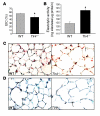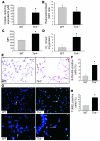Toll-like receptor 4 deficiency causes pulmonary emphysema
- PMID: 17053835
- PMCID: PMC1616193
- DOI: 10.1172/JCI28139
Toll-like receptor 4 deficiency causes pulmonary emphysema
Abstract
TLRs have been studied extensively in the context of pathogen challenges, yet their role in the unchallenged lung is unknown. Given their direct interface with the external environment, TLRs in the lungs are prime candidates to respond to air constituents, namely particulates and oxygen. The mechanism whereby the lung maintains structural integrity in the face of constant ambient exposures is essential to our understanding of lung disease. Emphysema is characterized by gradual loss of lung elasticity and irreversible airspace enlargement, usually in the later decades of life and after years of insult, most commonly cigarette smoke. Here we show Tlr4(-/-) mice exhibited emphysema as they aged. Adoptive transfer experiments revealed that TLR4 expression in lung structural cells was required for maintaining normal lung architecture. TLR4 deficiency led to the upregulation of what we believe to be a novel NADPH oxidase (Nox), Nox3, in lungs and endothelial cells, resulting in increased oxidant generation and elastolytic activity. Treatment of Tlr4(-/- )mice or endothelial cells with chemical NADPH inhibitors or Nox3 siRNA reversed the observed phenotype. Our data identify a role for TLR4 in maintaining constitutive lung integrity by modulating oxidant generation and provide insights into the development of emphysema.
Figures







References
-
- Zhang X., et al. Cutting edge: TLR4 deficiency confers susceptibility to lethal oxidant lung injury. J. Immunol. 2005;175:4834–4838. - PubMed
-
- Qureshi S.T., et al. Inducible activation of TLR4 confers resistance to hyperoxia-induced pulmonary apoptosis. J. Immunol. 2006;176:4950–4958. - PubMed
-
- Jiang D., et al. Regulation of lung injury and repair by Toll-like receptors and hyaluronan. Nat. Med. 2005;11:1173–1179. - PubMed
-
- MacNee W. Pulmonary and systemic oxidant/antioxidant imbalance in chronic obstructive pulmonary disease. Proc. Am. Thorac. Soc. 2005;2:50–60. - PubMed
-
- Rennard S.I., Vestbo J. COPD: the dangerous underestimate of 15%. Lancet. 2006;367:1216–1219. - PubMed
Publication types
MeSH terms
Substances
Grants and funding
LinkOut - more resources
Full Text Sources
Other Literature Sources
Molecular Biology Databases

